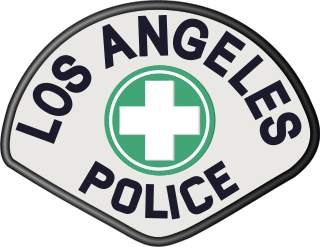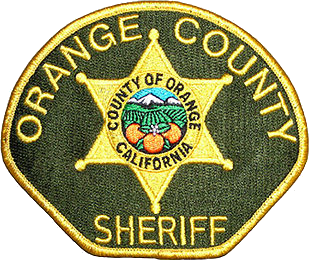
The Los Angeles Police Department (LAPD), officially known as the City of Los Angeles Police Department, is the primary law enforcement agency of Los Angeles, California, United States. With 8,967 officers and 3,000 civilian staff, it is the third-largest municipal police department in the United States, after the New York City Police Department and the Chicago Police Department.

The Community Resources Against Street Hoodlums (CRASH) was a specialized gang intelligence unit of the Los Angeles Police Department (LAPD) tasked with combating gang-related crime between 1979 and 2000. The unit was established in the South Central district of Los Angeles, California, United States, to combat rising gang violence during the period. Each of the LAPD's 18 divisions had a CRASH unit assigned to it, whose primary goal was to suppress gang-related crimes in the city, which came about primarily from the increase in illegal drug trade.

Daryl Francis Gates was the Chief of the Los Angeles Police Department (LAPD) from 1978 to 1992. His length of tenure in this position was second only to that of William H. Parker. Gates is co-credited with the creation of SWAT teams with LAPD's John Nelson, who others claim was the originator of SWAT in 1965. Gates also co-founded D.A.R.E.

The Rampart scandal was a police corruption scandal which unfolded in Los Angeles, California, United States, during the late 1990s and early 2000s. The scandal concerned widespread criminal activity within the Community Resources Against Street Hoodlums (CRASH) anti-gang unit of the Los Angeles Police Department's Rampart Division. More than 70 police officers were initially implicated in various forms of misconduct, including unprovoked shootings and beatings, planting of false evidence, stealing and dealing narcotics, bank robbery, perjury, and cover-ups thereof.

The Los Angeles School Police Department (LASPD) is a law enforcement agency in Los Angeles, California, whose duties are to provide police services to the Los Angeles Unified School District, also enforcing state and city laws. LASPD officers assist staff with disturbances and potential criminal activity on the campuses and in the surrounding communities on a daily basis.

Law Enforcement Exploring, commonly referred to as Police Explorers or Police Scouts, is an American vocational education program that allows youth to explore a career in law enforcement by working with local law enforcement agencies. Founded on July 12, 1973, it is one of the Exploring programs from Learning for Life, a non-Scouting affiliate of the Boy Scouts of America. The program is generally available to qualified young adults who graduated 8th grade and are ages 14 through 21.

The California Department of Corrections and Rehabilitation (CDCR) is the penal law enforcement agency of the government of California responsible for the operation of the California state prison and parole systems. Its headquarters are in Sacramento.

The Rampart Division of the Los Angeles Police Department (LAPD) serves communities to the west of Downtown Los Angeles (DTLA) including Silver Lake, Echo Park, Pico-Union and Westlake, all together designated as the Rampart patrol area. Its name is derived from Rampart Boulevard, one of the principal thoroughfares in its patrol area. The original station opened in 1966, located at 2710 West Temple Street. In 2008, the staff moved southeast to a newer facility located at 1401 West 6th Street. With 164,961 residents occupying a 5.4-square-mile (14 km2) area, Rampart is one of Los Angeles's most densely populated communities.
The Jungles faction of the Black P. Stones street gang is a division ("set") of the Bloods gang alliance in Los Angeles. Originating in Los Angeles' Baldwin Village neighborhood in the 1960s, the Black P. Stones became one of the largest gangs in the city. The gang has been linked to various crimes, including murders, assaults, robberies, narcotics violations and firearms violations, and has been the subject of numerous FBI and LAPD investigations.

The Orange County Sheriff's Department (OCSD) is the law enforcement agency serving Orange County, California. It currently serves the unincorporated areas of Orange County and thirteen contract cities in the county: Aliso Viejo, Dana Point, Laguna Hills, Laguna Niguel, Laguna Woods, Lake Forest, Mission Viejo, Rancho Santa Margarita, San Clemente, San Juan Capistrano, Stanton, Villa Park, and Yorba Linda.

The Torrance Police Department is the police department serving Torrance, California.

The Los Angeles Police Department (LAPD) was formed in 1869, and has since become the third-largest law enforcement agency in the United States. They have been involved in various events in history, such as the Black Dahlia murder, the Watts riots, the 1992 Los Angeles riots, the North Hollywood shootout, the murder trial of O. J. Simpson, and the Rampart scandal.
The 2007 MacArthur Park rallies were two May Day rallies demanding amnesty for undocumented immigrants which occurred on May 1, 2007, at MacArthur Park, in Los Angeles.
Crime in Los Angeles has varied throughout time, reaching peaks between the 1970s and 1990s. Since the early 2020s, crime has increased in Los Angeles.

Metropolitan Division, commonly referred to as Metro Division or just Metro, is an elite division of the Los Angeles Police Department (LAPD) under its Special Operations Group. Metropolitan Division is responsible for managing the LAPD's specialized crime suppression, K-9, mounted, and SWAT units, named "platoons".

George Gascón is an American attorney and former police officer who is the district attorney of Los Angeles County. A member of the Democratic Party and a former Republican, Gascón served as the district attorney of San Francisco from 2011 to 2019. Prior to his work as a prosecutor, he was an assistant chief of police for the LAPD, and Chief of Police in Mesa, Arizona and San Francisco.
The City of Los Angeles Park Ranger Division is a Park Ranger division serving the City of Los Angeles, California parks. The headquarters of the City of Los Angeles Park Rangers is located at the Griffith Park visitor's center. The division is a specialized agency controlled by the Department of Parks and Recreation and employs 22 Park Rangers who are sworn peace officers under 830.31 of the California Penal Code.

Ezell Ford, a 25-year-old African-American man, died from multiple gunshot wounds after being shot by Los Angeles Police Department (LAPD) officers in Florence, Los Angeles, California on August 11, 2014. In the weeks and months that followed, Ford's shooting triggered multiple demonstrations and a lawsuit by Ford's family claiming $75 million in damages.

The killing of Charley Leundeu Keunang, a 43-year-old Cameroonian national, occurred in Los Angeles, California, on March 1, 2015. He was shot by three Los Angeles Police Department officers.

Stephen Downing is an American screenwriter, producer, activist, and investigative journalist who began his screenwriting career in the 1960s while still working as a Los Angeles Police Department (LAPD) officer. Most of Downing's pre-1980 writing and producing credits appeared under pseudonyms to escape notice of the LAPD. Downing is active in the movement to end the international war on drugs and the militarization of police in America. In 2011, Downing became a board member of Law Enforcement Action Partnership, formerly known as Law Enforcement Against Prohibition (LEAP), after years representing the group as a speaker. He left the board in 2019, but is still an advisory board member who gives speeches and writes op-ed pieces on behalf of the group. He also volunteers his time as an investigative journalist, with a focus on police corruption and reform, for a local print newspaper in Long Beach, California. As a television producer and screenwriter he is best known for the series Walking Tall, RoboCop: The Series, T. J. Hooker and MacGyver.























